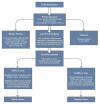Adaptation and coping in patients living with an LVAD: A metasynthesis
- PMID: 27342261
- PMCID: PMC5035582
- DOI: 10.1016/j.hrtlng.2016.05.035
Adaptation and coping in patients living with an LVAD: A metasynthesis
Abstract
Objective: To synthesize information supporting coping and adaptation of LVAD patients and to identify opportunities for future interventions.
Background: Left Ventricular Assist Device (LVAD) patients demonstrate improvements in quality of life and functional status, but qualitative research has not been meaningfully integrated.
Methods: Qualitative meta-synthesis using Lazarus and Folkmans' Transactional Model of stress and coping.
Results: Four distinct stages of adaptation were identified: Pre-LVAD, Implant Hospitalization, Early Home Adaptation and Late Home Adaptation. Each stage includes tasks in physical, psychological and social domains. Two themes emerged: 1) Primary Appraisal: Every stage is a new challenge and 2) Secondary Appraisal: Routines are achievable, emotions are more difficult.
Conclusions: Emotional challenges including fear and anxiety related to life-limiting illness and changed social roles need to be honestly addressed. Individuals living with LVAD achieve a sense of independence, enjoy social interactions and meaningful activities through addressing practical and emotional problems to facilitate coping.
Keywords: Adaptation; Coping; Heart failure; LVAD; Left Ventricular Assist Device.
Copyright © 2016 Elsevier Inc. All rights reserved.
Figures
References
-
- Kirklin JK, Naftel DC, Pagani FD, et al. Sixth INTERMACS annual report: a 10,000- patient database. J Heart Lung Transplant. 2014;33(6):555–64. doi:10.1016/j.healun.2014.04.010. - PubMed
-
- Rose E, Gelijns AC, Moskowitz AJ, et al. LONG-TERM USE OF A LEFT VENTRICULAR ASSIST DEVICE. N Engl J Med. 2001;345(20):1435–1443. a. - PubMed
-
- Grady KL, Meyer PM, Dressler D, et al. Longitudinal change in quality of life and impact on survival after left ventricular assist device implantation. Ann Thorac Surg. 2004;77(4):1321–7. doi:10.1016/j.athoracsur.2003.09.089. - PubMed
-
- Brouwers C, Denollet J, de Jonge N, Caliskan K, Kealy J, Pedersen SS. Patient-reported outcomes in left ventricular assist device therapy: a systematic review and recommendations for clinical research and practice. 2011 doi:10.1161/CIRCHEARTFAILURE.111.962472. - PubMed
Publication types
MeSH terms
Grants and funding
LinkOut - more resources
Full Text Sources
Other Literature Sources
Medical



